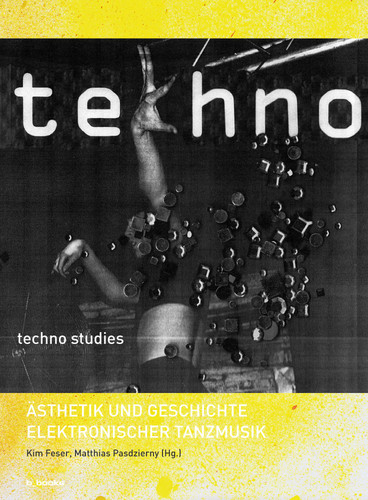Techno Studies
Contact
<link universitaet fakultaet-musik institute institut-fuer-musikwissenschaft-musiktheorie-komposition-und-musikuebertragung musikwissenschaft personen-der-musikwissenschaft kim-feser internal-link>Kim Feser and Matthias Pasdzierny
Berlin University of the Arts, College of Music, Musicology
Book, 2016
Techno Studies. Ästhetik und Geschichte elektronischer Tanzmusik
[Techno Studies. Aesthetics and History of electronic dance music],
ed. Kim Feser / Matthias Pasdzierny, Berlin: b_books 2016.
(German · 248 p. · 20 € · ISBN 978-3-942214-25-4 · Orders can be placed at verlag(at)bbooks.de)
With contributions by:
Kim Feser / Matthias Pasdzierny, Rosa Reitsamer, Jochen Bonz, Diedrich Diederichsen, Luis-Manuel Garcia, Daniel Schneider, Judith Keilbach, Matthias Pasdzierny, Sean Nye, Stefan Goldmann, Barbara Volkwein, Martha Brech, Jens Gerrit Papenburg, Mark J. Butler, Kim Feser; Sascha Kösch (Bleed), Carsten Meyer / Jacques Palminger / Klaus Walter.
You can find the titles of the contributions from the German version here (no English version planned).
From the introduction:
Current developments in the field of electronic dance music are often perceived as variants of House or Electro, or – not only in the English-speaking world – subsumed under the inconspicuous abbreviation EDM (Electronic Dance Music). Techno, on the other hand, seems to have outlived its function as an umbrella term. While it is still frequently used, it increasingly evokes feelings of historization, with different layers of meaning in different locations. One of the reasons for this perception are the journalistic contributions on the history of Techno published since the 1990s, which put the focus on certain protagonists, events and locations as well as drugs or music devices in connection with tracks that are considered most important. Particularly in Germany, a focus on contemporary history can be observed in film and TV productions, especially from the past few years. The increasing museification of artifacts from the ‘Techno-movement’ amplifies the feeling that Techno is rather a historical fact than a term to describe the current versatility of the scene – at least there are probably less connotated terms. It seems, however, that an unbroken attractiveness arises from the tension between the historicity of a youth-/sub-culture that has gotten a bit long in the tooth and the various tendencies to musically renew it. This tension oscillates in the term Techno in a particularly compressed way.
The existing scientific research, which investigates musical aspects and trends or phenomena of a youth-, pop-, club-, or rave culture, which is mainly based on music, tries to put itself in relation to the popular discourses and genre descriptions. In the research, more or less broad ideas of the terms Electronic Dance Music, Techno, House, Acid or Elektronika are applied on specific historical and locational phenomena. The book Techno Studies, which is based on a series of presentations given at the eponymous conference in December 2014 and a lecture series delivered at the Berlin University of the Arts, bundles different approaches from different disciplines and countries and puts them up for debate to give the field new impulses. At the same time, the book gives an account of Techno-related research conducted so far: In the focus and the disciplinary alignment of these studies, the close link and mutual influence between discourses within the scene as well as popular and socio-political discourses and debates in academic contexts can be observed. The apparent tautology of “Techno Studies” and “Ästhetik und Geschichte elektronischer Tanzmusik” (Aesthetics and History of electronic dance music) in the title of the book shows, on the one hand, the diverse language-specific expressions – whereby “Techno” / English and “elektronische Tanzmusik” / German are interchanged in today’s typical application context. On the other hand, this tautology emphasizes the relation between aesthetic and historiographic reflection as the central methodological challenge in the approach to this music.
